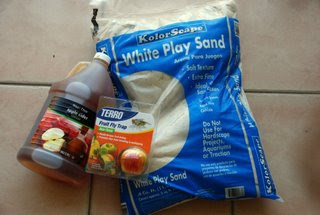I am generally a peace loving individual, but these !#@% gnats have gone too far! It started with a few gnats on a Greek Oregano plant I brought home from the nursery. The gnats have spread to my other plants, reproduced and are waging a full-scale invasion of my herb garden. I've tried a number of things to fight back.
1. I let the watering lapse in my plants to dry out the top layers of soil.
Results: This did not work, because my plants needed water before all of the gnats died.
2. I've sprayed the soil gnat larvae on my bougainvillea with an eco-friendly mixture of Dawn and water.
Results: This did effectively kill the larvae, however if even one gnat survives you are back to square one.
This morning I found soil gnat larvae on my cilantro. Eww! I lost the first battle, but I am determined not to lose the war. I found a very helpful video on eradicating soil gnats with a few solutions I haven't tried yet. Check it out:
Getting Rid of Indoor Gnats
This advice seems sound, so I went shopping and armed myself with the following tools:
1. Play Sand. The idea is simple. Soil gnats live in the first few inches of wet top soil. If you let the topsoil dry out completely, eventually the soil gnats will die. However, if I let the top soil dry out completely eventually my plants will die. The solution is to put something dry on the top few inches of your soil, such as play sand. When you water your plants the water will drain quickly through the sand to the soil below. This sand is sold in garden centers everywhere, so it must be useful. Soil gnats will not live in the play sand, so you have eliminated the need to stop watering. This sounds feasible. I have high hopes for this. I think it will help deter other insects as well.
2. Apple Cider Vinegar. According to the advice in the video, soil gnats are attracted to the smell of wine or apple cider vinegar. This makes sense as well, since one of these annoying gnats flew into my glass of pinot noir last night. The idea is to put out bowls of apple cider vinegar, which will attract the gnats away from your plants. The gnats fly in for a drink and drown. I plan to put these bowls out after I add the layers of sand to my topsoil. My reasoning is that the gnats will be looking for a new place to live and find the apple cider vinegar welcoming.
3. Fruit Fly Trap. I've never seen any type of over-the-counter product for eliminating soil gnats. I have seen one for eliminating fruit flies. I don't think I have fruit flies, but since they are also attracted to sweet smells, I thought this trap might work just as well for soil gnats. I'll let you know how it works.
If none of these methods work, I will have to repot all of my plants. I am hoping to avoid this as it is costly, messy and time consuming. If you have any experience eradicating soil gnats from your garden, feel free to comment.

































